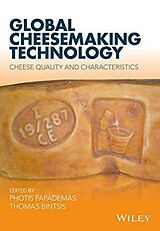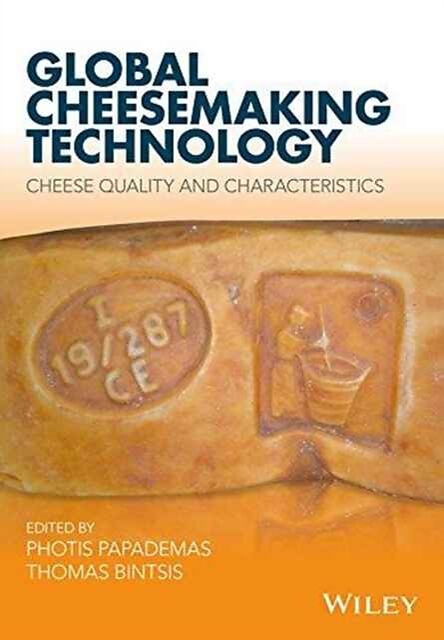Global Cheesemaking Technology
Einband:
Fester Einband
EAN:
9781119046158
Genre:
Biology
Autor:
Photis Bintsis, Thomas Papademas
Herausgeber:
Wiley-Blackwell
Erscheinungsdatum:
01.12.2017
Lieferung vom Verlag mit leichten Qualitätsmängeln möglich
Autorentext
About the Editors
PHOTIS PAPADEMAS is Assistant Professor of Dairy Science and Technology at the Department of Agricultural Sciences, Biotechnology and Food Science, Cyprus University of Technology, Cyprus. THOMAS BINTSIS is a consultant to the dairy industry and auditor of food safety management systems, and was formerly an adjunct lecturer at the Technological Education Institute of West Macedonia, Greece.
Inhalt
List of Contributors xxv Preface xxix Part I 1
1 The History of Cheese 3
Paul S. Kindstedt 1.1 Introduction 3 1.2 Origins of Cheese 3 1.3 Cheese in Antiquity 7 1.4 Cheese in the Middle Ages and Renaissance 10 1.5 Cheese in the Modern Era 12 References 14 2 From Micelle to Melt: The Influence of Calcium on Physico-chemical Properties of Cheese 20
Darren R. Cooke and Paul L.H. McSweeney 2.1 Introduction 20 2.2 Calcium Equilibrium in Bovine Milk 21 2.3 Calcium Equilibrium in Cheese 25 2.4 The Influence of Calcium on Cheese Rheology and Functionality 31 2.5 Conclusions 40 References 40 3 Cheese Flavour Development and Sensory Characteristics 45
Kieran Kilcawley and Maurice O'Sullivan 3.1 Introduction 45 3.2 Biochemical Pathways Involved in Cheese Flavour 46 3.3 Sensory Methods 58 3.4 Data Analysis, Chemometrics and Preference Mapping 63 3.5 Conclusion 63 References 64 4 Cheese Microbial Ecology and Safety 71
Antonia Picon 4.1 Introduction 71 4.2 Source of Microorganisms in Cheese 71 4.3 Factors Influencing the Growth of Microorganisms in Cheese 72 4.4 Cheese Microbiota 72 4.5 Cheese Pathogens 77 4.6 Other Risks of Microbial Origin 81 4.7 Growth and Survival of Bacterial Pathogens in Cheese 82 4.8 Procedures to Improve Cheese Safety 84 4.9 Conclusions and Future Trends 89 References 89 5 Cheeses with Protected Land- and Tradition-Related Labels: Traceability and Authentication 100
Luiz Javier R. Barron, Noelia Aldai, Mailo Virto and Mertxe de Renobales 5.1 Introduction: Protected Land- and Tradition-Related Labels 100 5.2 Traceability 103 5.3 Authentication: What Should Be Authenticated? 103 5.4 Innovation, Modern Technologies and Traditional Cheeses 112 5.5 Conclusions 113 Acknowledgements 113 References 113 6 An Overview of the Cheesemaking Process 120
Thomas Bintsis and Photis Papademas 6.1 Introduction 120 6.2 Milk Types and Composition 121 6.3 Raw Milk Quality for Cheesemaking 123 6.4 Additives in Cheese Milk 126 6.5 Milk Standardisation 127 6.6 Treatments of Raw Milk for Cheesemaking 127 6.7 Acidification 129 6.8 Coagulation 131 6.9 Post-Coagulation Processes 132 6.10 Control of Cheesemaking Steps 136 6.11 Cheese Maturation 136 6.12 Adjunct Cultures and Acceleration of the Maturation Process 137 6.13 Packaging 138 6.14 Main Cheese Categories 140 References 152 7 Traditional Wooden Equipment Used for Cheesemaking and Their Effect on Quality 157
Giuseppe Licitra, Margherita Caccamo, Florence Valence and Sylvie Lortal 7.1 Introduction to Traditional Cheeses 157 7.2 Traditional Equipment 158 7.3 Biofilms of Wooden Vats 161 7.4 Wooden Shelves 163 7.5 Legislation Concerning Wood in Contact with Milk or Cheeses 164 7.6 Cleaning Systems 165 7.7 Safety Assessment 167 7.8 Conclusions 168 References 169 Part II 173 Introduction 175 Cheeses from Argentina 175 Acknowledgements 175 References 176 Cheeses from Cyprus 176 Reference 177 Cheeses from Denmark 177 References 178 Cheeses from France 178 Cheeses from Germany 179 Cheeses from Greece 180 Reference 181 Cheeses from Italy 181 Cheeses from Malta 183 Cheeses from the Netherlands 183 Cheeses from Portugal 184 Cheeses from Serbia 185 References 186 Cheeses from Slovakia 186 Cheeses from Spain 187 Acknowledgements 188 Cheeses from Sweden 188 References 189 Cheeses from Switzerland 190 Acknowledgements 190 Cheeses from Turkey 191 References 192 Cheeses from the United Kingdom 192 1 Extra-Hard Cheeses 194
Giuseppe Licitra, Erica R. Hynes, Maria Cristina Perotti, Carina V. Bergamini, Elisabeth Eugster-Meier, Marie-Therese Fröhlich-Wyder, Ernst Jakob and Daniel Wechsler 1.1 Parmigiano Reggiano PDO - Italy 194 1.2 Reggianito Cheese - Argentina 197 Acknowledgements 199 1.3 Sbrinz PDO - Switzerland 199 References 201 2 Hard Cheeses 204
Katja Hartmann, Giuseppe Licitra, Elisabeth Eugster-Meier, Marie-Therese Fröhlich-Wyder, Ernst Jakob, Daniel Wechsler, Jean L. Maubois, Kimon-Andreas G. Karatzas, Thomas Bintsis, Efstathios Alichanidis, Maria Belén López Morales, Françoise Berthier, rem Uzunsoy, Barbaros Özer and Ylva Ardö 2.1 Allgäu Mountain Cheese - Germany 204 2.2 Asiago PDO - Italy 206 2.3 Berner Alpkäse PDO and Berner Hobelkäse PDO - Switzerland 210 2.4 Cantal PDO - France 213 2.5 Cheddar - United Kingdom 214 2.6 Cheshire - United Kingdom 216 2.7 Fiore Sardo PDO - Italy 218 2.8 Graviera Kritis PDO - Greece 220 2.9 Idiazabal PDO - Spain 222 2.10 Kefalograviera PDO - Greece 224 2.11 Kefalotyri - Greece 226 2.12 Le Gruyère PDO - Switzerland 228 2.13 Ossau Iraty PDO - France 230 2.14 Tête de Moine PDO, Fromage de Bellelay - Switzerland 233 2.15 Tulum Cheese -Turkey 235 2.16 Västerbottensost - Sweden 237 2.17 Würchwitzer Mite Cheese - Germany 239 References 241 3 Semi-hard Cheeses 247
Elisabeth Eugster-Meier, Marie-Therese Fröhlich-Wyder, Ernst Jakob, Daniel Wechsler , Maria Belén López Morales, Giuseppe Licitra, Françoise Berthier, Photis Papademas, Ylva Ardö, Tânia G. Tavares, F. Xavier Malcata, Zorica Radulovic and Jelena Miocinovic 3.1 Appenzeller ® - Switzerland 247 3.2 Arzúa-Ulloa PDO - Spain 250 3.3 Castelmagno PDO - Italy 253 3.4 Comté PDO - France 256 3.5 Flaouna Cheese - Cyprus 259 3.6 Formaggio di Fossa di Sogliano PDO - Italy 260 3.7 Havarti - Denmark 263 3.8 Herrgård - Sweden 264 3.9 Mahón-Menorca PDO - Spain 267 3.10 Majorero PDO - Spain 269 3.11 Manchego PDO - Spain 271 3.12 Murcia al Vino PDO - Spain 274 3.13 Präst - Sweden 276 3.14 Raclette du Valais PDO - Switzerland 278 3.15 Raclette Suisse ® -Switzerland 280 3.16 San Simón da Costa PDO-Spain 282 3.17 Svecia PGI - Sweden 285 3.18 Serpa - Portugal 286 3.19 Sombor Cheese - Serbia 289 3.20 Tuma Persa PDO - Italy 291 References 293 4 Soft Cheeses (with Rennet) 301
Maria Belén López Morales, Thomas Bintsis, Efstathios Alichanidis, Karol Herian, Paul Jelen, Erica R. Hynes, Maria Cristina Perotti, Carina V. Bergamini, Everaldo Attard , Anthony Grupetta, Stefania Carpino, Tânia G. Tavares and F. Xavier Malcata 4.1 Afuegäl Pitu PDO - Spain 301 4.2 Anevato PDO - Greece 304 4.3 Bryndza - Slovakia 305 4.4 Cremoso - Argentina 307 Acknowledgements 309 4.5 Galotyri PDO - Greece 310 4.6 Kopanisti PDO - Greece 311 4.7 Maltese bejna - Malta 312 …

Leider konnten wir für diesen Artikel keine Preise ermitteln ...
billigbuch.ch sucht jetzt für Sie die besten Angebote ...
Die aktuellen Verkaufspreise von 6 Onlineshops werden in Realtime abgefragt.
Sie können das gewünschte Produkt anschliessend direkt beim Anbieter Ihrer Wahl bestellen.
Loading...
Die aktuellen Verkaufspreise von 6 Onlineshops werden in Realtime abgefragt.
Sie können das gewünschte Produkt anschliessend direkt beim Anbieter Ihrer Wahl bestellen.
| # | Onlineshop | Preis CHF | Versand CHF | Total CHF | ||
|---|---|---|---|---|---|---|
| 1 | Seller | 0.00 | 0.00 | 0.00 |
